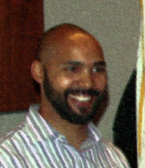CIVIC DIALOG
by Brian Moore

Although this discussion is supposed to focus on civic dialogue, let me start with a seemingly unrelated topic. Some of the greatest things I learned in college about management, public (and non-public) participation, and planning, came from dance classes focused on composition and improvisation. You may find this surprising, but yes, an education in dance can provide a person resources to be effective in these areas of study.
So then, how does a dance education relate to civic dialogue? In a word, improvisation. For those unfamiliar with the idea of improvisation, it is an approach to composition (usually dance and music) where the content is created in "real time” (to use an awful digital age marketing phrase). This means that the performance is determined by the dancers or musicians in the beginning, middle, and end of performing. The quality of the results are highly dependent on both the skill, training, and practice of the performers but also on their decision making ability. The decision making process relies on the individual’s ability to understand three components of the performance: what has happened in the performance (a sort of narrative understanding), what is happening with solos and groupings of other performers, and what they can do to contribute to a cohesive performance. The resulting performance is the totality of each individual’s ability to engage the other artists in a musical or physical dialogue about what is happening for the performance right now.
With this idea of improvisation in mind, we must take a second look at our built environment, the neighborhoods, business districts, industrial centers, and transportation. And we have to do so while we are in the middle of the whole process. We must develop our understanding of the performance and evaluate our effectiveness at engaging the other “artists” in dialogue about how we are planning our world. This civic dialogue is our opportunity to recognize that our progress is as a group and it is our responsibility to provide opportunities for each other to succeed in creating functional, beautiful, and interesting places.
One of the core purposes of the VULUPS art project is to develop a civic dialogue about the planning and development process. When planners and decision makers pursue their work without helping the broader community understand the process, the community will respond with defensiveness and negativity. When the private sector is not engaged in understanding the importance their work, the performance of our cities and places suffers. Therefore, VULUPS, is an opportunity for planners and decision makers to engage in a process that can reconnect them to the narrative of place that we are creating every day. It is also an opportunity to engage artists from the community in a learning process of how we create our spaces. As one of the coordinators of the VULUPS project, I hope the art we create will reflect the process and learning that all of the participants will experience. Thank you for your interest and let’s make some great art!
So then, how does a dance education relate to civic dialogue? In a word, improvisation. For those unfamiliar with the idea of improvisation, it is an approach to composition (usually dance and music) where the content is created in "real time” (to use an awful digital age marketing phrase). This means that the performance is determined by the dancers or musicians in the beginning, middle, and end of performing. The quality of the results are highly dependent on both the skill, training, and practice of the performers but also on their decision making ability. The decision making process relies on the individual’s ability to understand three components of the performance: what has happened in the performance (a sort of narrative understanding), what is happening with solos and groupings of other performers, and what they can do to contribute to a cohesive performance. The resulting performance is the totality of each individual’s ability to engage the other artists in a musical or physical dialogue about what is happening for the performance right now.
With this idea of improvisation in mind, we must take a second look at our built environment, the neighborhoods, business districts, industrial centers, and transportation. And we have to do so while we are in the middle of the whole process. We must develop our understanding of the performance and evaluate our effectiveness at engaging the other “artists” in dialogue about how we are planning our world. This civic dialogue is our opportunity to recognize that our progress is as a group and it is our responsibility to provide opportunities for each other to succeed in creating functional, beautiful, and interesting places.
One of the core purposes of the VULUPS art project is to develop a civic dialogue about the planning and development process. When planners and decision makers pursue their work without helping the broader community understand the process, the community will respond with defensiveness and negativity. When the private sector is not engaged in understanding the importance their work, the performance of our cities and places suffers. Therefore, VULUPS, is an opportunity for planners and decision makers to engage in a process that can reconnect them to the narrative of place that we are creating every day. It is also an opportunity to engage artists from the community in a learning process of how we create our spaces. As one of the coordinators of the VULUPS project, I hope the art we create will reflect the process and learning that all of the participants will experience. Thank you for your interest and let’s make some great art!
